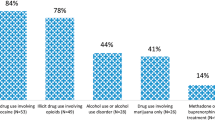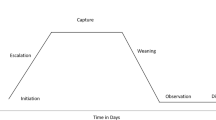Abstract
Objective
To report the incidence of torticollis diagnosed in infants treated for neonatal abstinence syndrome (NAS) and compare neonates with and without torticollis.
Study design
This prospective cohort study reports on infants examined at 1–4 months of age. Numerous obstetrical/newborn factors and other drugs used during gestation were compared.
Results
Of 501 neonates treated for NAS, 421 (84%) were seen for follow-up. Of these, 105 (24.9%) were diagnosed with torticollis. The only significant obstetrical/newborn factor identified was a lower rate if the parents were the primary caregiver after hospital discharge. Of the 105 cases, 88 (84%) were right-sided and 17 (16%) were left-sided.
Conclusions
These data demonstrate that torticollis is a common diagnosis in infants examined at 1–4 months of age after being treated for NAS with a predilection for this to be right-sided. The etiology for this is uncertain, but newborns treated for NAS need close follow-up post discharge.
This is a preview of subscription content, access via your institution
Access options
Subscribe to this journal
Receive 12 print issues and online access
$259.00 per year
only $21.58 per issue
Buy this article
- Purchase on Springer Link
- Instant access to full article PDF
Prices may be subject to local taxes which are calculated during checkout
Similar content being viewed by others
References
Patrick SW, Davis MM, Lehman CU, Cooper WO. Increasing incidence of geographic distribution of neonatal abstinence syndrome: United States 2009–2012. J Perinatol. 2015;35:650–5.
Patrick SW, Bauer AM, Warren MD, Jones TF, Wester C. Hepatitis C virus infection among women giving birth—Tennessee and United States, 2009–14. Morbidity Mortal Wkly Rep. 2017;66:470–3.
Towers CV, Hyatt BW, Visconti KC, Chernicky L, Chattin K, Fortner KB. Neonatal head circumference in newborns with neonatal abstinence syndrome. Pediatrics. 2019;143:e20180541.
McAllister JM, Hall ES, Hertenstein GER, Merhar SL, Uebel PL, Wexelblatt SL. Torticollis in infants with a history of neonatal abstinence syndrome. J Pediatr. 2018;196:305–8.
Burnette T, Chernicky L, Towers CV. The effect of standardizing treatment when managing neonatal abstinence syndrome. J Matern Fetal Neonatal Med. 2019;32:3415–9.
Cheng JC, Tang SP, Chen TM, Wong NW, Wong EM. The clinical presentation and outcome of treatment of congenital muscular torticollis in infants—a study of 1086 cases. J Pediatr Surg. 2000;35:1091–6.
Boere-Boonekamp NM, van der Linder-kuiper LT. Postural preference: prevalence in infants and follow-up after two years. Pediatrics. 2001;107:339–43.
Do TT. Congenital muscular torticollis: current concepts and review of treatment. Curr Opin Pediatr. 2006;18:26–29.
Nuysink J, van Haastert IC, Takken T, Helders PJ. Symptomatic asymmetry in the first six months of life: differential diagnosis. Eur J Pediatr. 2008;167:613–9.
Stellwagen L, Hubbard E, Chambers C, Jones KL. Torticollis, facial asymmetry and plagiocephaly in normal newborns. Arch Dis Child. 2008;93:827–31.
Hall ES, McAllister JM, Wexelblatt SL. Developmental disorders and medical complications among infants with subclinical intrauterine opioid exposures. Popul Health Manag. 2019;22:19–24.
Van Vlimmeren LA, Helders PJM, Van Adrichem LNA, Engelbert RHH. Torticollis and plagiocephaly in infancy: therapeutic strategies. Pediatr Rehabil. 2006;9:40–46.
Kuo AA, Tritasavit S, Graham JM. Congenital muscular torticollis and positional plagiocephaly. Pediatr Rev. 2014;35:79–86.
Andersen KW, Siebner HR. Mapping dexterity and handedness: recent insights and future challenges. Curr Opin Behav Sci. 2018;20:123–9.
Faurie C, Schiefenhovel W, Le Bomin S, Billiard S, Raymond M. Variation in the frequency of left-handedness in traditional societies. Curr Anthropol. 2005;46:142–7.
Van Agtmael T, Forrest SM, Williamson R. Parametric and non-parametric linkage analysis of several candidate regions for genes for human handedness. Eur J Hum Genet. 2002;10:623–30.
Ransil BJ, Schachter SC. Test-retest reliability of the Edinburgh Handedness Inventory and Global Handedness preference measurements, and their correlation. Percept Mot Skills. 1009;79:1355–72.
Basco WT. Torticollis: a consequence of neonatal abstinence syndrome? Medscape; 2018. https://www.medscape.com/viewarticle/898794. Accessed 26 Dec 2019.
Acknowledgements
Presented at the 39th Annual Pregnancy Meeting of the Society for Maternal-Fetal Medicine; February 11–16, 2019; Las Vegas, Nevada.
Author information
Authors and Affiliations
Contributions
CVT conceptualized and co-designed the study, coordinated and supervised the maternal and neonatal data collection, carried out the initial analyses, drafted the initial manuscript, and approved the final manuscript as submitted. AK and RN carried out the maternal/neonatal data collection, critically reviewed the manuscript, and approved the final manuscript as submitted. MG and TB co-designed the study, supervised the neonatal data collection, critically reviewed and revised the manuscript, and approved the final manuscript as submitted. MH supervised the maternal data collection, critically reviewed and revised the manuscript, and approved the final manuscript as submitted.
Corresponding author
Ethics declarations
Conflict of interest
The authors declare that they have no conflict of interest.
Additional information
Publisher’s note Springer Nature remains neutral with regard to jurisdictional claims in published maps and institutional affiliations.
Rights and permissions
About this article
Cite this article
Towers, C.V., Knapper, A., Gaylord, M. et al. Torticollis in infants with neonatal abstinence syndrome. J Perinatol 41, 615–618 (2021). https://doi.org/10.1038/s41372-019-0580-x
Received:
Revised:
Accepted:
Published:
Issue Date:
DOI: https://doi.org/10.1038/s41372-019-0580-x



